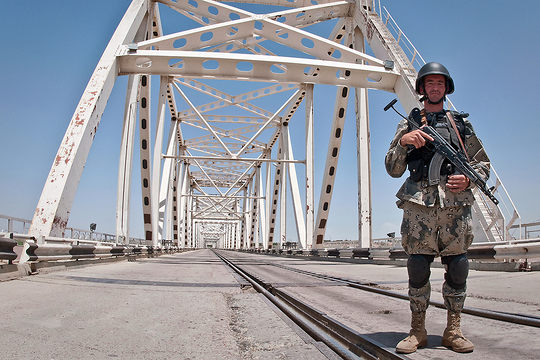
NATO Supply Routes to Afghanistan Under Threat
Publication: Eurasia Daily Monitor Volume: 8 Issue: 221
By:

“Issue ignored is a crisis invited,” Henry Kissinger once famously said writing on US foreign policy. This sums up the predicament in which the US may find itself if it fails to address the risks stemming from Pakistan’s decision to close NATO supply routes in response to an attack on its soldiers by US forces and Russia’s warnings to review its cooperation on Afghanistan in response to the US missile defense plans in Europe. Russia is unlikely to close the US-led Northern Distribution Network (NDN) transiting provisions to coalition forces in Afghanistan, for fear of undermining regional security and its ties with the US, but it does feel threatened by the missile defense initiative and tries to pressure Washington to at least compromise on the plan, if not discard it entirely. The situation forces the US to find viable policy tools to prevent what some fear could be an ultimate foreign policy crisis.
Pakistan closed NATO supply routes after US forces killed 24 Pakistani soldiers on November 26. Currently, 48 percent of NATO supplies go through Pakistan. This figure would have been higher had it not been for the NDN, which now runs 60 percent of fuel and 52 percent of non-lethal NATO supplies through Russia, the South Caucasus, and Central Asia. The NDN’s role is set to persist, while the dependence on Pakistan-controlled routes to bring in military supplies will decrease as coalition forces pull out of Afghanistan. As an anonymous source put it, “…We are out in 2014. Therefore the value of NDN is out, not in” (Eurasianet, November 28).
Pakistan’s closure of supply routes and other measures taken in response to the attack on its soldiers puts more than 100,000 coalition forces at risk. Islamabad has already asked the US to leave Shamsi airbase within 15 days and ordered a review of military cooperation with the US and NATO, claiming the “deliberate” attack violated its sovereignty (Asia Times Online, December 1). “Enough is enough. The government will not tolerate any incident of spilling even a single drop of any civilian or soldier’s blood,” Pakistan’s Foreign Minister Hina Rabbani Khar said (Reuters, December 1). NATO reports that Pakistan has resumed some cooperation with the Alliance after the attack (www.rferl.org, November 30).
US-Pakistani relations hit a low point after a covert US operation killed Osama Bin Laden inside Pakistan in May. Conflicting priorities over the war in Afghanistan have fueled tensions between the two countries. Islamabad now feels more comfortable pursuing a harsh anti-US line, in part because the withdrawal of coalition forces may conclude with the emergence of a Taliban-controlled government in Kabul. Pakistani military and intelligence services may not yet have switched sides, but they are cautious not to ignore the interests of the Taliban as coalition forces seem increasingly unlikely to bring the war to a successful conclusion.
Meanwhile, increased terrorist activity in Pakistan – in part the alleged result of Islamabad’s support to terrorist groups – has threatened the country’s security. Violations of its airspace and regular casualties further make the Pakistani authorities and public question the goodwill of its partners and undermine the trust of its allies, as the closure of the routes demonstrated.
Pakistan’s decision comes at an opportune time for Russia, whose envoy to NATO, Dmitry Rogozin, shortly afterwards threatened a review of Russia’s cooperation on Afghanistan if the US and NATO failed to address Moscow’s concerns over US missile defense plans in Europe. “If our partners do not react to the statements which were predictable and proportionate to risks and threats, we will have to reconsider our relations with our partners in other areas as well,” Rogozin said, adding that this review could include Afghanistan (www.rosbalt.ru, November 28; www.vedomosti.ru, November 28). He said Russia views the missile system as a “legitimate target” for attack (IRNA, December 3). The “reset” appears to be taking its last breath as the presidential election season approaches in both the US and Russia.
Rogozin’s statements follow the recent warnings by President Dmitry Medvedev to equip Russia’s ballistic missiles with advanced defense-penetration systems, deploy tactical missiles close to Europe, and withdraw from START III, if Russia’s “legitimate security interests” in upholding “strategic nuclear parity” are ignored. Moscow has been unable to secure a legally-binding agreement from Washington that the missile defense shield, currently deployed in Romania, Poland, Turkey, and Israel, would not threaten Russia’s security. At the Russia-NATO summit last year, Medvedev proposed creating a joint missile defense system: “Europe does not need new dividing lines. It needs a common security perimeter, with Russia participating in it as an equal partner” (www.rt.com, November 23 and 30).
The efforts by Russian elites to promote Russia as an “equal” and “respected” partner capable of standing up to the US represent a long-standing psychological and geopolitical tradition, which coexists well with the Kremlin’s fear of what the US can hardly enforce today given its relative decline on the world stage – the policy of containment. In a move resembling Pakistan’s, Russia has signaled it can hit Washington where it hurts most – Afghanistan. Moscow’s review of cooperation on Afghanistan could result in major complications for the NDN, thereby undermining the war effort at a time when relying on Pakistan for supply routes is in question. But Russia’s possible willingness to scrap the NDN is not its desired outcome in the short run: the security of Russia’s southern frontiers depends on stability in Central and South Asia, which is and has to be partially maintained by US military.
Moscow is thus hostile to a foreign military presence in its periphery, but is also cognizant of its inability to enforce stability unilaterally in Europe, Central and South Asia. One year ago, Rogozin cautioned that NATO’s premature withdrawal would destabilize Central Asia and lead to “inflows of thousands of refugees to Russia and Europe.” He also asked for NATO to stay, adding that Russia was willing to help through means other than intervention. “We insist that NATO troops stay in the country until the necessary conditions are provided to establish stable local authorities capable of independently deterring radical forces and controlling the country. That is why we are helping NATO by providing transit for goods and training personnel for Afghanistan, including anti-narcotics officers,” he stated (www.centrasia.ru, December 1, 2010).
Stocked-up supplies and reliance on the NDN thus far enables the US and NATO to sustain the war that for many looks no longer winnable, especially following Pakistan’s decision to close NATO supply routes. Concerns over the future course of ties with Islamabad and Moscow’s warnings to review cooperation on Afghanistan suggest the US may be forced to compromise with both “allies.” With presidential elections soon taking place in the US and Russia, striking a bargain could prove difficult yet also imperative in order to avoid a major foreign policy crisis.




